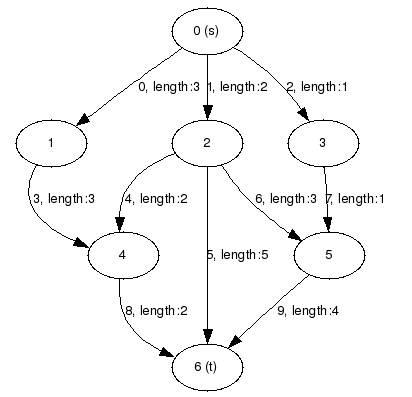EdgeSubGraphAdaptor< Graph, EdgeFilterMap > Class Template Reference
[Adaptor Classes for Graphs]
Detailed Description
template<typename Graph, typename EdgeFilterMap>
class lemon::EdgeSubGraphAdaptor< Graph, EdgeFilterMap >
An adaptor for hiding edges from a graph. This adaptor specializes SubGraphAdaptor in the way that only the edge-set can be filtered. The usefulness of this adaptor is demonstrated in the problem of searching a maximum number of edge-disjoint shortest paths between two nodes s and t. Shortest here means being shortest w.r.t. non-negative edge-lengths. Note that the comprehension of the presented solution need's some elementary knowledge from combinatorial optimization.
If a single shortest path is to be searched between s and t, then this can be done easily by applying the Dijkstra algorithm. What happens, if a maximum number of edge-disjoint shortest paths is to be computed. It can be proved that an edge can be in a shortest path if and only if it is tight with respect to the potential function computed by Dijkstra. Moreover, any path containing only such edges is a shortest one. Thus we have to compute a maximum number of edge-disjoint paths between s and t in the graph which has edge-set all the tight edges. The computation will be demonstrated on the following graph, which is read from the dimacs file sub_graph_adaptor_demo.dim. The full source code is available in sub_graph_adaptor_demo.cc. If you are interested in more demo programs, you can use dim_to_dot.cc to generate .dot files from dimacs files. The .dot file of the following figure was generated by the demo program dim_to_dot.cc.

Graph g;
Node s, t;
LengthMap length(g);
readDimacs(std::cin, g, length, s, t);
cout << "edges with lengths (of form id, source--length->target): " << endl;
for(EdgeIt e(g); e!=INVALID; ++e)
cout << g.id(e) << ", " << g.id(g.source(e)) << "--"
<< length[e] << "->" << g.id(g.target(e)) << endl;
cout << "s: " << g.id(s) << " t: " << g.id(t) << endl;
typedef TightEdgeFilterMap<Graph, const Dijkstra::DistMap, LengthMap> TightEdgeFilter; TightEdgeFilter tight_edge_filter(g, dijkstra.distMap(), length); typedef EdgeSubGraphAdaptor<Graph, TightEdgeFilter> SubGA; SubGA ga(g, tight_edge_filter);
s-t paths are computed with a max flow algorithm Preflow. ConstMap<Edge, int> const_1_map(1);
Graph::EdgeMap<int> flow(g, 0);
Preflow<SubGA, ConstMap<Edge, int>, Graph::EdgeMap<int> >
preflow(ga, const_1_map, s, t);
preflow.run();
cout << "maximum number of edge-disjoint shortest path: " << preflow.flowValue() << endl; cout << "edges of the maximum number of edge-disjoint shortest s-t paths: " << endl; for(EdgeIt e(g); e!=INVALID; ++e) if (preflow.flow(e)) cout << " " << g.id(g.source(e)) << "--" << length[e] << "->" << g.id(g.target(e)) << endl;
edges with lengths (of form id, source--length->target):
9, 5--4->6
8, 4--2->6
7, 3--1->5
6, 2--3->5
5, 2--5->6
4, 2--2->4
3, 1--3->4
2, 0--1->3
1, 0--2->2
0, 0--3->1
s: 0 t: 6
maximum number of edge-disjoint shortest path: 2
edges of the maximum number of edge-disjoint shortest s-t paths:
9, 5--4->6
8, 4--2->6
7, 3--1->5
4, 2--2->4
2, 0--1->3
1, 0--2->2
#include <lemon/graph_adaptor.h>

 1.5.9
1.5.9